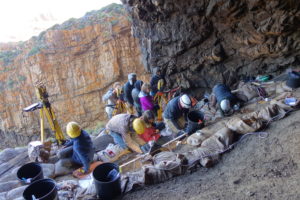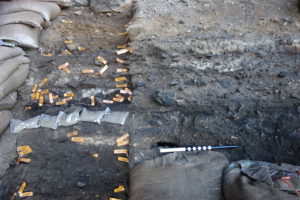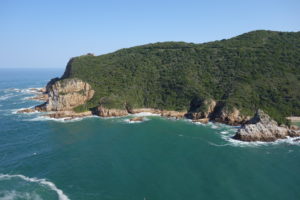

O uso do fogo no final da Idade da Pedra Média no sul da África / The use of fire at the end of the Middle Stone Age in southern Africa
Ximena S. Villagran; CNPq Produtividade em Pesquisa – Nível 2 (301617/2018-0)
PI do projeto financiado pela NSF no qual se insere esta pesquisa: Profa. Naomi Cleghorn (University of Texas – Arlington)
Sobre o projeto: Este projeto contempla o estudo micromorfológico do sítio Knysna Eastern Heads Cave 1 (KEH-1), recentemente descoberto na costa sul da África do Sul e datado do final da Idade da Pedra Média (Middle Stone Age: MSA, 250.000 – 30.000 anos AP). O sítio está localizado em uma caverna quartzítica de frente para o Oceano Índico, cuja entrada está cerca de 23 m acima do nível do mar. Escavações preliminares abertas em 2014 produziram uma sequência de ocupação humana que começa há 44.000 anos AP e se estende através do Ultimo Máximo Glacial até 18.000 anos AP. Existem evidências de ocupação humana nos níveis inferiores àquele datado em 44.000 AP com cronologias que adentram na Idade da Pedra Média. A sequência de ocupação do sítio se enquadra em um dos períodos mais críticos do registro arqueológico do sul da África e oferece uma oportunidade rara para investigar as respostas humanas às flutuações ambientais e às mudanças na paisagem que desembocaram no Último Máximo Glacial. O período da pré-história humana abrangido na sequência do sítio KEH-1 representa o preâmbulo da intensificação de recursos e do aumento demográfico que caracteriza as ocupações humanas durante o Holoceno, tanto na África como em outros continentes. A resposta humana às flutuações climáticas e culturais durante a transição entre a Idade da Pedra Média e a Idade da Pedra Tardia (Later Stone Age: LSA, 50.000 – 8 000 anos AP) no sul da África do Sul será estudada a partir do estudo micro-geoarqueológico das fogueiras do sítio KEH-1.
About the project This project consists of a micromorphological study of the site Knysna Eastern Heads Cave 1 (KEH-1), recently discovered on the south coast of South Africa and dated to the end of the Middle Stone Age (MSA, 250,000–30,000 years BP). The site is located in a quartzite cave facing the Indian Ocean, whose entrance is 23 m above sea level. Preliminary excavations opened in 2014 produced a sequence of human occupation that started around 44,000 years BP and extended through the Last Glacial Maximum until 18,000 years BP. There is evidence for human occupation in levels inferior to those dated to 44,000 BP with chronologies that fall into the Middle Stone Age. The site occupation sequence is situated within one of the most critical periods of the archaeological record of South Africa and offers a rare opportunity to investigate human responses to the environmental fluctuations and landscape changes that culminated in the Last Glacial Maximum. The period of human prehistory covered by the KEH-1 site represents the preamble of the intensification of resource use and demographic increase that characterizes human occupations during the Holocene in Africa and other continents. The human response to climatic and cultural fluctuations during the transition between the Middle and Late Stone Age (LSA, 50,000–8,000 BP) in South Africa will be studied through a micro-geoarchaeological study of hearths from the KEH-1 site.
PI of the NSF project that includes this research: Prof. Naomi Cleghorn (University of Texas – Arlington)

Escavação do sítio Knysna Eastern Heads Cave 1 (África do Sul) pela equipe liderada pela Profa. Naomi Cleghorn / Excavation at Knysna Eastern Heads Cave 1 (South Africa) by the team leaded by Prof. Naomi Cleghorn.

Perfil estratigráfico do sítio Knysna Eastern Heads Cave 1 / Stratigaphic profile of Knysna Eastern Heads Cave 1.

Vista de um dos grandes afloramentos de quartzito na entrada do estuário de Knysna / View of one of the large quartzite outcrops at the entrance of Knysna estuary.
Copyright © 2024 Laboratório de Microarqueologia | Produzido por SCS - Mídias Online

